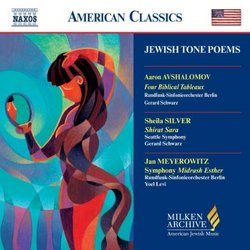| All Artists: Aaron Avshalomov, Jan Meyerowitz, Sheila Silver, Gerard Schwarz, Yoel Levi, Berlin Symphony Orchestra, Seattle Symphony Orchestra, Sinfonie Orchester Berlin, Sinfonie-Orchester Berlin Title: Jewish Tone Poems (Milken Archive of American Jewish Music) Members Wishing: 1 Total Copies: 0 Label: Milken Archive Release Date: 7/20/2004 Genre: Classical Styles: Historical Periods, Modern, 20th, & 21st Century, Symphonies Number of Discs: 1 SwapaCD Credits: 1 UPC: 636943942628 |
Search - Aaron Avshalomov, Jan Meyerowitz, Sheila Silver :: Jewish Tone Poems (Milken Archive of American Jewish Music)
 | Aaron Avshalomov, Jan Meyerowitz, Sheila Silver Jewish Tone Poems (Milken Archive of American Jewish Music) Genre: Classical
This disc presents premiere recordings of works about Biblical heroines by three very different composers. Avshalomov, born in Siberia, spent most of his life in China, but eventually settled in Oregon. Basically self-taug... more » |
Larger Image |
CD Details
Synopsis
Amazon.com
This disc presents premiere recordings of works about Biblical heroines by three very different composers. Avshalomov, born in Siberia, spent most of his life in China, but eventually settled in Oregon. Basically self-taught, he was influenced by Ernest Bloch and developed a tonal, eclectic style combining Western romanticism and orchestration with traditional Chinese elements. Though only loosely connected to Judaism, he formed close ties with the Jewish communities of Shanghai and Portland; the latter commissioned "Four Tableaux" in 1928. The music, portraying Esther, Rebecca, Ruth and Naomi, is mostly somber, but concludes with a triumphant fanfare. Though recognition eluded him, Ashvalomov left a musical legacy: his son Jacob and grandson David are composers, his grandson Daniel is a violist. Seattle-born Silver wrote "Song of Sarah" in 1985 in Israel, inspired by a mournful Hassidic tune she heard through a yeshiva window. Depicting Sarah's grief at her barrenness, her prayer for a child and its miraculous fulfillment, it is a strong, dramatic piece using both tonality and atonality, with melodic fragments over an obsessively motoric, murmurous undercurrent. Scored for strings, its substantial, soaring solo violin part is played very well by the (unidentified) concertmaster. Born in Germany to a family of Christian converts, Meyerowitz discovered his Jewish heritage accidentally in his teens. After fleeing to Italy and France, he came to America in 1946, quickly establishing himself as teacher and composer. His music is emotional, skillfully crafted, tonal, eclectic, rooted but not locked in his European past. "Midrash Esther," written in 1954, evokes rather than relates the biblical story. The solemn first movement depicts the Jews' desperate situation, the second Haman's hatred with agitated passages, ominous dissonant crashes, a distorted march. The third is a tender, intimate love-duet between Esther and Ahasuerus on strings and woodwinds, the fourth transforms catastrophe into triumph. --Edith Eisler

 Track Listings (11) - Disc #1
Track Listings (11) - Disc #1